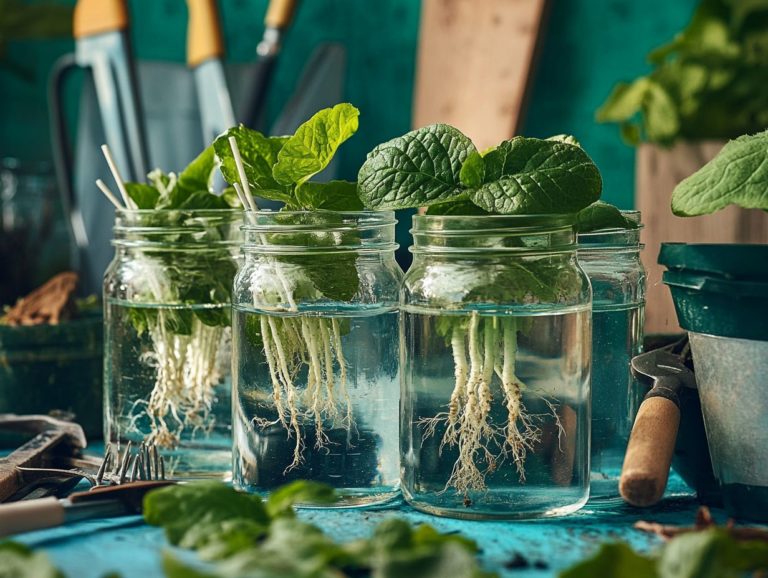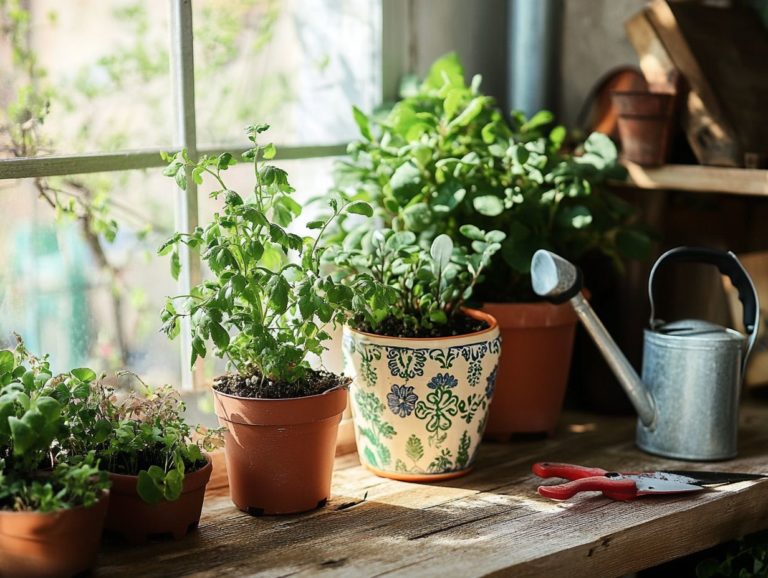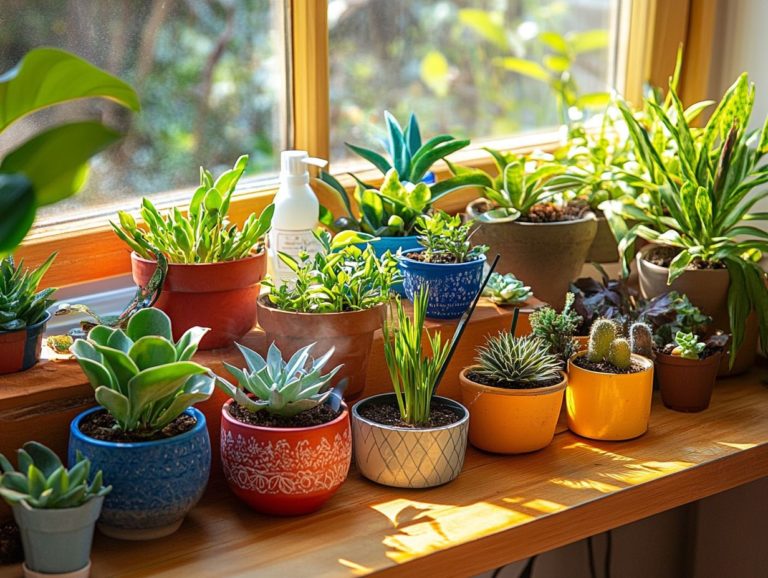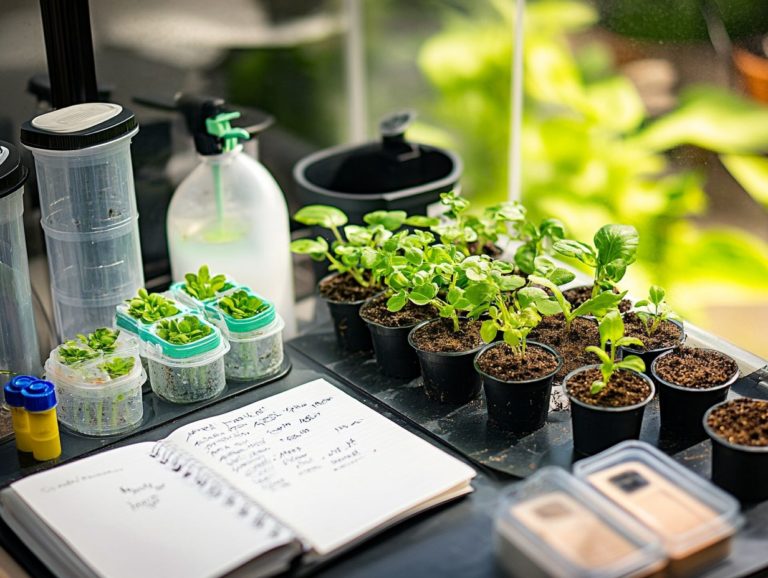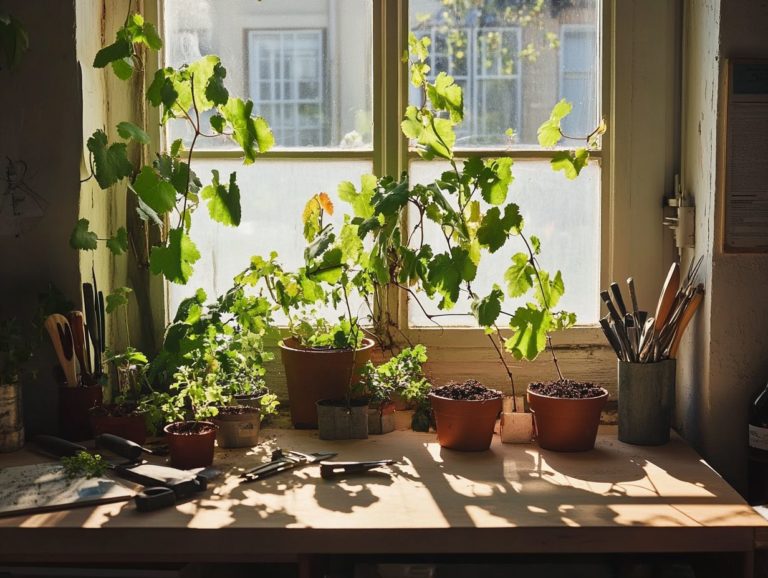Top 5 Methods for Indoor Plant Propagation
Plant propagation is your gateway to crafting new plants from the ones you already cherish. This art not only enriches the collections of plant lovers but also enhances wellness by infusing your space with vibrant greenery. It is a gratifying way for you to expand your green space while keeping your wallet happy.
Whether you consider yourself a seasoned plant parent or are just beginning your journey, mastering propagation methods will empower you to grow your collection effectively and transform your home into a lively oasis, teeming with life.
From water propagation, which has become a beloved technique for plant lovers eager to propagate houseplants from cuttings, to air layering, each method boasts its unique charm and benefits.
This guide unveils the top five methods for propagating indoor plants, complete with essential tools, common pitfalls to avoid, and tips for achieving success. Dive in to discover how you can nurture new plants from your beloved favorites using propagation stations for indoor plants!
Contents
- Key Takeaways:
- 1. Water Propagation
- 2. Stem Cutting Propagation
- 3. Leaf Cutting Propagation
- 4. Division Propagation
- 5. Air Layering Propagation
- What Is Indoor Plant Propagation and Why Is It Important?
- Frequently Asked Questions
- What are the top 5 methods for indoor plant propagation?
- How do I propagate plants using stem cuttings?
- What is the process for propagating plants using leaf cuttings?
- Can I propagate plants by division?
- What is layering and how is it used for plant propagation?
- Is seed propagation a good method for indoor plants?
Key Takeaways:
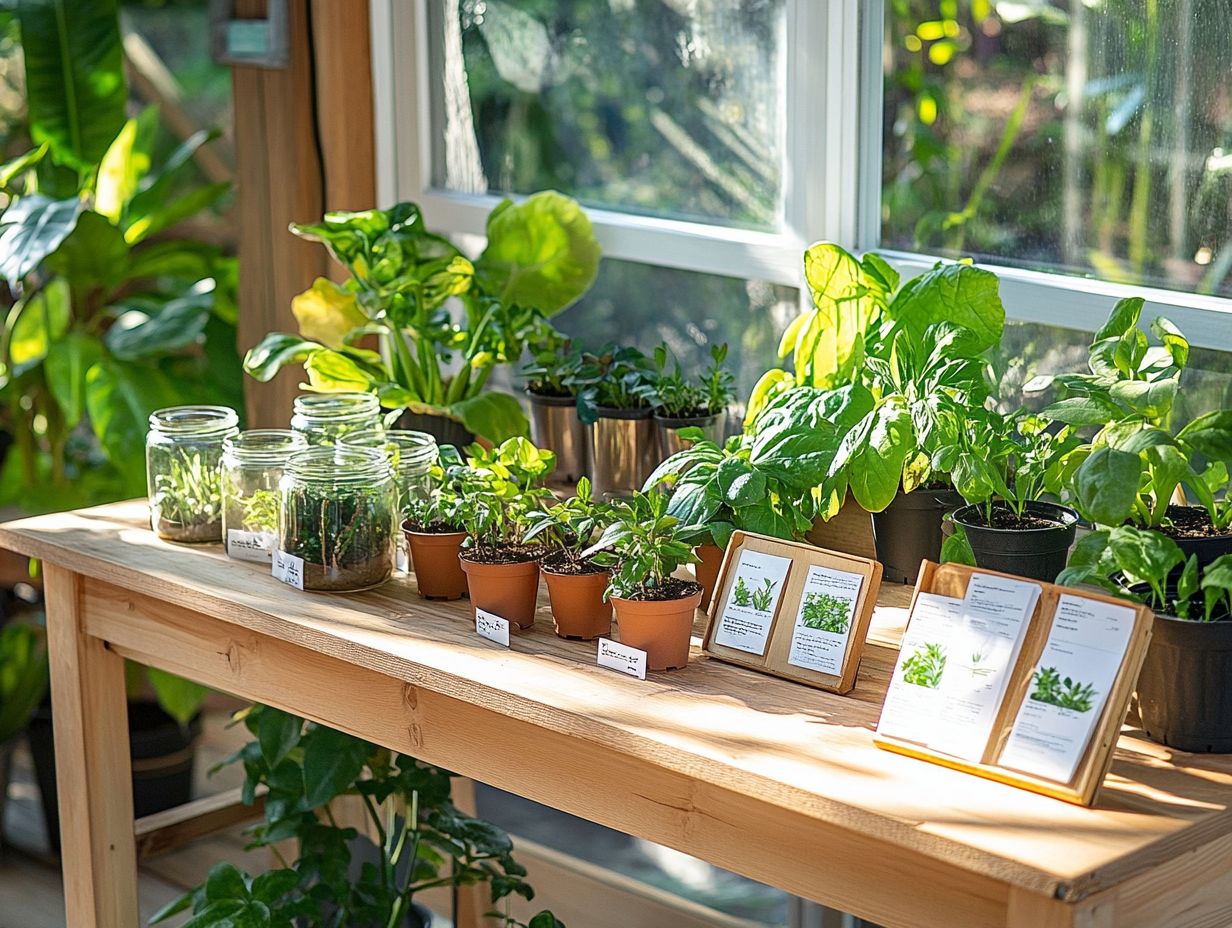
- Water propagation is a simple and cost-effective method that involves placing cuttings in water.
- Stem cutting propagation involves cutting a part of the stem and rooting it in soil or water to produce a new plant.
- Leaf cutting propagation is popular for plants with large, fleshy leaves, where a leaf is cut and rooted in soil or water to grow a new plant.
1. Water Propagation
Water propagation is a technique that many plant enthusiasts adore for growing new houseplants from cuttings. This method uses water to promote healthy root development, making it accessible for both novice gardeners and seasoned plant gurus.
To embark on this rewarding journey, start by selecting healthy sections of your plants, ideally cutting just below a node this is a small bump on the stem where roots can grow. Using sharp, clean scissors is essential to minimize damage and reduce the risk of disease.
Once your cuttings are prepared, place them in a vessel filled with fresh water, ensuring at least one node is submerged to enhance the chances of successful rooting. Maintaining optimal moisture conditions is crucial; cuttings thrive best in bright, indirect light, away from harsh sunlight that could cause stress.
You can use rooting hormones to stimulate root growth, creating a vibrant environment for new life to flourish. Regularly changing the water helps prevent stagnation and keeps your cuttings healthy, leading to a thriving new chapter for both you and your leafy companions.
2. Stem Cutting Propagation
Stem cutting propagation is an exceptionally effective technique for nurturing many indoor plants. As a plant parent, you have the opportunity to grow new plants from existing ones, provided you adhere to proper gardening techniques that ensure a high success rate in your propagation experience.
The process begins with the careful selection of healthy stems from your parent plant. Use clean, sharp shears to make your cuts and allow the stems to callus briefly before planting them. Aim for a well-draining mix, typically a combination of potting soil and perlite or vermiculite, which enhances aeration.
Most cuttings thrive in indirect sunlight, which helps prevent scorching. Some common houseplant varieties that adapt particularly well to this method include Pothos, spider plants, and succulents. With the right care, all of these can flourish from stem cuttings, transforming your indoor garden into a vibrant sanctuary.
Start propagating now to see your collection flourish!
3. Leaf Cutting Propagation
Leaf cutting propagation is a fascinating technique, particularly suited for specific plant species like Peperomia argyreia and Rex begonia. This method allows you to multiply rare houseplants using leaf sections to cultivate healthy new specimens.
Not only does this technique provide a cost-effective way to expand your collection, but it also immerses you in a rewarding, hands-on gardening experience.
When selecting the best cuttings, it’s vital to choose healthy, mature leaves that are free from any signs of disease or damage, ensuring the best chances of successful growth.
Environmental factors, such as humidity and light, are crucial to the success of your propagation efforts. By maintaining elevated humidity levels often achieved through misting or covering your cuttings you’ll encourage robust root development. Providing bright, indirect light creates ideal conditions for new growth. Understanding these elements will greatly enhance your journey in nurturing new plant life.
4. Division Propagation
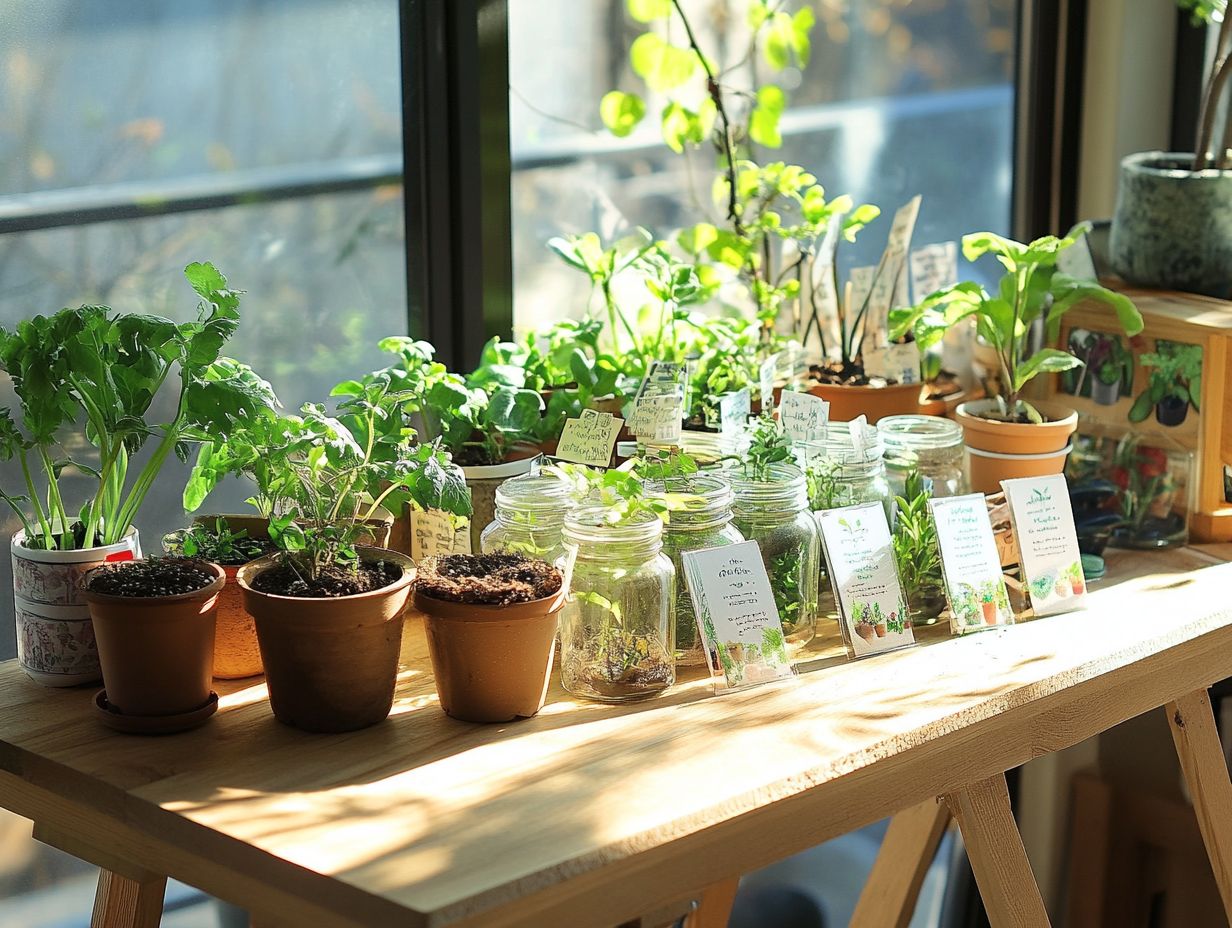
Division propagation is a favored technique among plant enthusiasts, renowned for its simplicity and effectiveness. This method lets you easily transform a mature plant into several new ones, each capable of establishing in quality potting soil.
To navigate this process successfully, it s essential to select robust nursery plants that showcase healthy foliage and strong root systems, ensuring they possess the vitality necessary for regrowth. Focus on perennials that have become overcrowded, as they will benefit significantly from division.
Once you ve carefully separated the plant into manageable pieces, providing adequate care becomes paramount. Water thoroughly while ensuring proper drainage to prevent root rot.
Utilizing a well-aerated soil mixture enriched with organic matter can greatly enhance your chances of successful root development, fostering strong growth in the new sections.
5. Air Layering Propagation
Air layering propagation is an advanced technique that you, as an aspiring plant stylist, will come to appreciate. This method involves encouraging root development on a stem while it’s still connected to the parent plant, allowing you to create a new plant with a solid foundation of healthy roots.
Mastering this technique requires careful attention, as its success depends on making precise cuts on the stem. By carefully removing a ring of bark to expose the layer of the stem that helps roots grow, you create an ideal environment for roots to emerge. Using rooting hormone can further enhance this process, promoting quicker and more vigorous root growth.
To maintain the necessary humidity for effective rooting, wrap the area with a moisture-retentive medium like sphagnum moss and cover it with plastic. Keeping an eye on moisture levels and ensuring adequate drainage are also critical steps in your journey toward successful air layering propagation.
What Is Indoor Plant Propagation and Why Is It Important?
Indoor plant propagation is your gateway to crafting new plants from the ones you already cherish. This art not only enriches the collections of plant enthusiasts but also enhances well-being by infusing your space with vibrant greenery.
By mastering propagation techniques, you can transform your home into a lively oasis, teeming with life. Methods like stem cuttings, division, and layering cater to various species, each presenting its own unique advantages and challenges. For instance, incorporating the top tropical plants for indoor environments can enhance your space even further.
As you delve into the world of indoor plant propagation, you’ll cultivate a deeper bond with your greenery, ensuring your own well-being while creating an environment that elevates both air quality and aesthetics. Sharing your propagated plants with friends or using them to beautify different areas fosters a sense of community and personal growth, making this endeavor a truly rewarding pursuit for anyone passionate about nurturing their indoor landscape.
What Are the Benefits of Propagating Indoor Plants?
Propagating indoor plants brings a wealth of benefits your way. You can save money and expand your indoor garden, all while nurturing your mental wellness through the art of gardening and creating living decor.
But the perks don t stop there. Cultivating new plants can dramatically improve your indoor air quality by filtering out toxins and releasing oxygen. Each new sprout you nurture becomes a testament to your investment of time and care, providing a profound sense of satisfaction.
Watching your plants flourish sparks joy and encourages mindfulness. It offers a soothing focal point to help you navigate daily stresses. Engaging with the vibrant greenery around you can elevate your mood and foster a sense of well-being, making your space feel more alive and harmonious.
Ultimately, propagating plants enhances your home s beauty and boosts your holistic mental health.
What Are the Essential Tools for Indoor Plant Propagation?
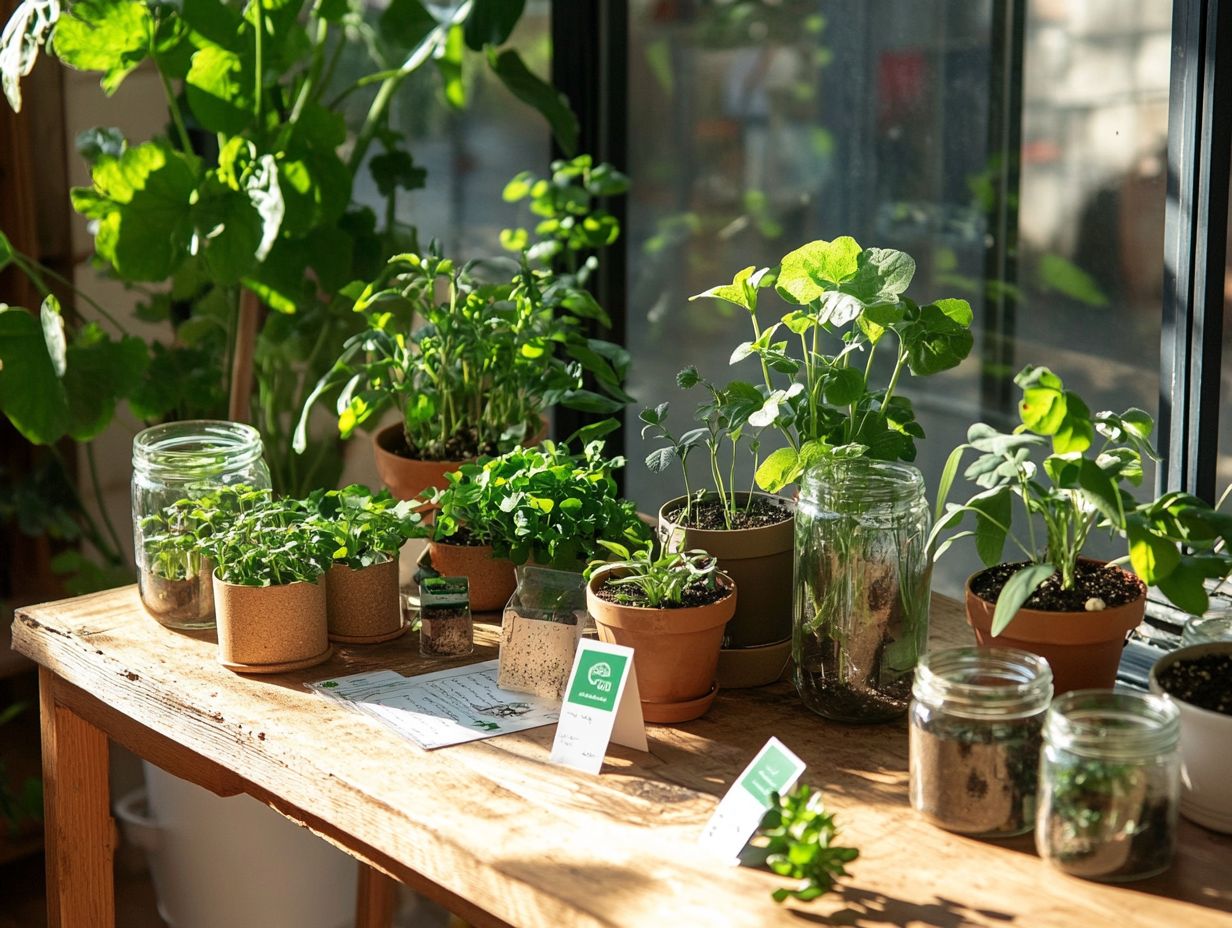
Having the right essential tools for indoor plant propagation is crucial for your success. They enable you to effectively utilize cutting methods and maintain the ideal conditions for your new plants.
Among these tools, propagation containers are essential. They create a controlled environment ideal for rooting. Clear plastic cups or glass jars not only allow you to see the developing roots but also help retain moisture, ensuring your plants have what they need to thrive.
Sharp cutting tools, like scissors or pruning shears, are essential for making clean cuts, which minimizes damage to the plant’s vascular system. Selecting the right type of soil, such as a well-draining potting mix or perlite, will provide optimal support and nutrition as the new roots establish themselves, paving the way for healthier and more resilient plants.
What Are the Best Plants for Each Propagation Method?
Understanding the ideal plants for each propagation method can greatly enhance your success in growing new green companions. By selecting houseplant varieties that thrive with specific techniques like stem cuttings or water propagation you set yourself up for flourishing results.
For those just starting out, consider the ever-popular pothos, which roots effortlessly in water, making it an excellent choice for this method. Spider plants are another fantastic option, celebrated for their ability to produce adorable baby ‘pups’ that can be easily separated and potted up.
If your interest leans towards soil propagation, look no further than monstera or philodendron; these varieties thrive beautifully when propagated through stem cuttings, as long as you include at least one node (the part of the stem that can grow roots).
During the initial stages of growth, maintaining proper humidity and light conditions is crucial. This attention ensures your new cuttings develop robust root systems, preparing them to thrive in their new homes.
How Long Does It Take for Plants to Root Using These Methods?
The time it takes for plants to root using various propagation methods can vary significantly. It is largely influenced by factors like the type of cutting you re working with, the environmental conditions, and your watering routine. As a plant parent, understanding these variables is crucial.
For example, leaf cuttings tend to take their sweet time, often requiring anywhere from two to eight weeks to form roots. In contrast, stem cuttings usually root faster, sometimes within just a week. The efficiency of each method can also depend on the plant species; some are simply more inclined to propagate successfully than others. Ensuring adequate humidity, warmth, and light is essential for promoting healthy root development.
Monitoring your plants regularly is essential. By inspecting your cuttings for signs of growth or decay, you can help them transition into flourishing new plants. Act quickly to give your cuttings the best chance to thrive! Adjusting your care strategies based on these observations can significantly boost your rooting success.
What Are the Common Mistakes to Avoid in Indoor Plant Propagation?
Many plant parents make common mistakes in indoor plant propagation, such as misjudging watering techniques and choosing the wrong soil type. These oversights can hinder your success rate and the overall health of your new plants.
Such missteps can lead to issues like root rot or not getting enough nutrients, which can be detrimental to your budding plants. Pay close attention to how wet the soil is, light conditions, and humidity requirements unique to each plant species. Assessing these factors can dramatically boost your success!
By embracing these guidelines, you can transform your indoor garden into a thriving oasis of greenery and steer clear of the typical pitfalls that often discourage new plant enthusiasts.
Frequently Asked Questions
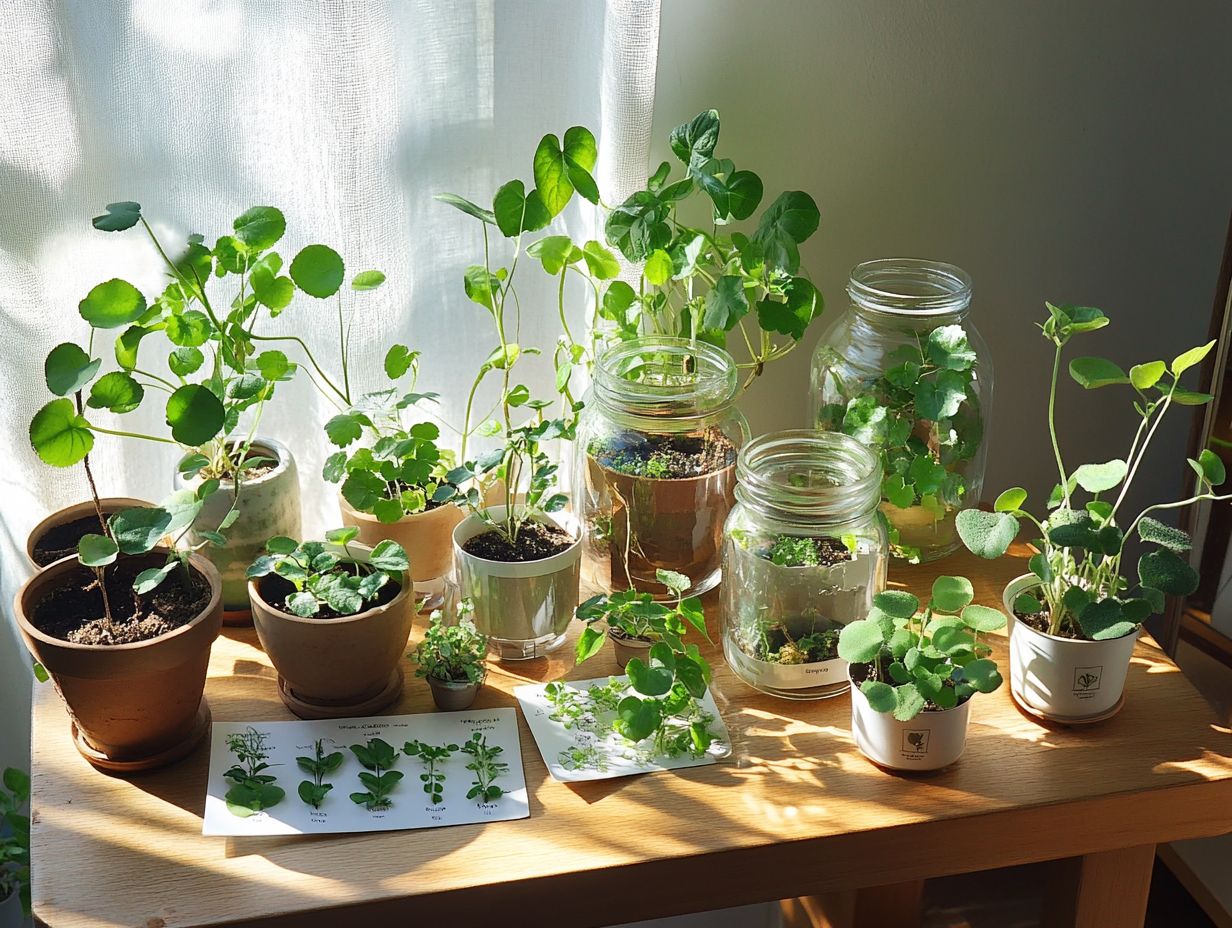
What are the top 5 methods for indoor plant propagation?
The top 5 methods for indoor plant propagation are:
- Stem cuttings
- Leaf cuttings
- Division
- Layering
- Seed propagation
How do I propagate plants using stem cuttings?
To propagate using stem cuttings:
- Select a healthy, mature stem and cut it just below a node.
- Remove any leaves from the bottom half of the stem.
- Place it in a jar of water or moist potting soil.
- Keep the cutting in a warm and bright location.
- Roots will start to form within a few weeks.
What is the process for propagating plants using leaf cuttings?
To propagate using leaf cuttings:
- Gently remove a leaf from a mature plant.
- Place it in a jar of water or moist potting soil, ensuring the stem end is submerged.
- Keep the cutting in a warm and bright location.
- Roots will form at the base of the leaf and a new plant will grow from there.
Can I propagate plants by division?
Yes, division is a common method for propagating indoor plants. It involves separating a mature plant into smaller sections, each with its own roots and shoots. This can be done with plants that have multiple stems or clumping roots, such as spider plants or peace lilies.
What is layering and how is it used for plant propagation?
Layering is a method where a stem from a mature plant is bent and partially buried in soil while still attached to the parent plant. Over time, roots will form at the buried section, and a new plant can be cut away and potted separately. This method works well for plants with flexible stems, such as philodendrons or pothos.
Is seed propagation a good method for indoor plants?
Seed propagation can be a bit more challenging for indoor plants, as it requires specific growing conditions and may take longer than other methods. However, it is a great option for plants that are difficult to propagate using other methods, or for those who want to start from scratch with a new plant.
Get started now and watch your indoor garden flourish!

